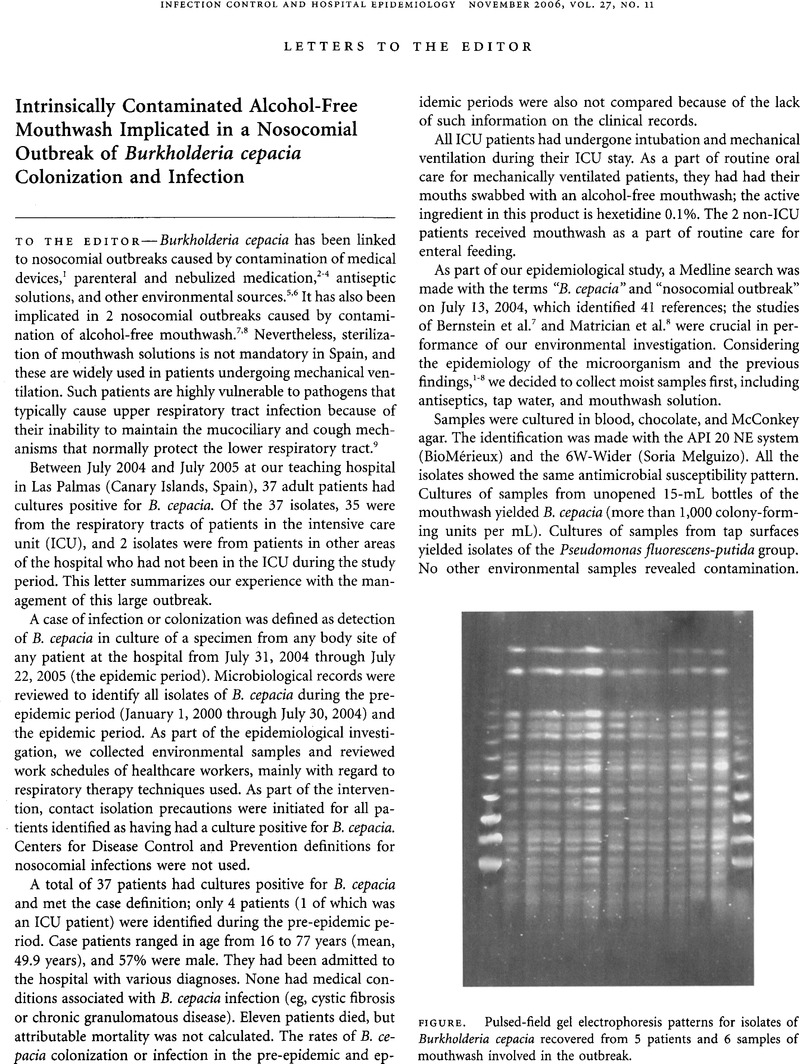Crossref Citations
This article has been cited by the following publications. This list is generated based on data provided by Crossref.
Kutty, Preeta K.
Moody, Barbara
Gullion, Jessica Smartt
Zervos, Marcus
Ajluni, Marie
Washburn, Rebecca
Sanderson, Roger
Kainer, Marion A.
Powell, Timothy A.
Clarke, Carmen F.
Powell, Renee J.
Pascoe, Neil
Shams, Alicia
LiPuma, John J.
Jensen, Bette
Noble-Wang, Judith
Arduino, Matthew J.
and
McDonald, L. Clifford
2007.
Multistate Outbreak of Burkholderia cenocepacia Colonization and Infection Associated With the Use of Intrinsically Contaminated Alcohol-Free Mouthwash.
Chest,
Vol. 132,
Issue. 6,
p.
1825.
Lundov, M. D.
and
Zachariae, C.
2008.
Recalls of microbiologically contaminated cosmetics in EU from 2005 to May 2008.
International Journal of Cosmetic Science,
Vol. 30,
Issue. 6,
p.
471.
Álvarez-Lerma, Francisco
Maull, Elena
Terradas, Roser
Segura, Concepción
Planells, Irene
Coll, Pere
Knobel, Hernando
and
Vázquez, Antonia
2008.
Moisturizing body milk as a reservoir of Burkholderia cepacia: outbreak of nosocomial infection in a multidisciplinary intensive care unit.
Critical Care,
Vol. 12,
Issue. 1,
Romero-Gómez, M. P.
Quiles-Melero, M. I.
García, P. Peña
Altes, A. Gutiérrez
de Miguel, M. A. García
Jiménez, C.
Valdezate, Sylvia
and
Nieto, J. A. Sáez
2008.
Outbreak ofBurkholderia cepaciaBacteremia Caused by Contaminated Chlorhexidine in a Hemodialysis Unit.
Infection Control & Hospital Epidemiology,
Vol. 29,
Issue. 4,
p.
377.
Romero-Gómez, M. P.
Quiles-Melero, M. I.
García, P. Peña
Altes, A. Gutiérrez
de Miguel, M. A. García
Jiménez, C.
Valdezate, Sylvia
and
Nieto, J. A. Sáez
2008.
Outbreak ofBurkholderia cepaciaBacteremia Caused by Contaminated Chlorhexidine in a Hemodialysis Unit.
Infection Control & Hospital Epidemiology,
Vol. 29,
Issue. 4,
p.
377.
Lundov, Michael Dyrgaard
Moesby, Lise
Zachariae, Claus
and
Johansen, Jeanne Duus
2009.
Contamination versus preservation of cosmetics: a review on legislation, usage, infections, and contact allergy.
Contact Dermatitis,
Vol. 60,
Issue. 2,
p.
70.
LiPuma, John J.
2010.
The Changing Microbial Epidemiology in Cystic Fibrosis.
Clinical Microbiology Reviews,
Vol. 23,
Issue. 2,
p.
299.
Martin, M.
Winterfeld, I.
Kramme, E.
Ewert, I.
Sedemund-Adib, B.
and
Mattner, F.
2012.
Ausbruch mit Burkholderia-cepacia-Komplex durch kontaminierte Mundspüllösung.
Der Anaesthesist,
Vol. 61,
Issue. 1,
p.
25.
Oie, S.
Arakawa, J.
Furukawa, H.
Matsumoto, S.
Matsuda, N.
and
Wakamatsu, H.
2012.
Microbial contamination of a disinfectant-soaked unwoven cleaning cloth.
Journal of Hospital Infection,
Vol. 82,
Issue. 1,
p.
61.
Medina-Pascual, M. J.
Valdezate, S.
Villalón, P.
Garrido, N.
Rubio, V.
and
Saéz-Nieto, J. A.
2012.
Identification, molecular characterisation and antimicrobial susceptibility of genomovars of the Burkholderia cepacia complex in Spain.
European Journal of Clinical Microbiology & Infectious Diseases,
Vol. 31,
Issue. 12,
p.
3385.
Souza Dias, Maria Beatriz
Cavassin, Larissa G.T.
Stempliuk, Valeska
Xavier, Luciene S.
Lobo, Renata D.
Sampaio, Jorge L.M.
Pignatari, Antonio Carlos
Borrasca, Vera L.
Bierrenbach, Ana Luiza
and
Toscano, Cristiana M.
2013.
Multi-institutional outbreak of Burkholderia cepacia complex associated with contaminated mannitol solution prepared in compounding pharmacy.
American Journal of Infection Control,
Vol. 41,
Issue. 11,
p.
1038.
Vardi, Anna
Sirigou, Antonia
Lalayanni, Chrysavgi
Kachrimanidou, Melina
Kaloyannidis, Panayiotis
Saloum, Riad
Anagnostopoulos, Achilles
and
Sotiropoulos, Damianos
2013.
An outbreak of Burkholderia cepacia bacteremia in hospitalized hematology patients selectively affecting those with acute myeloid leukemia.
American Journal of Infection Control,
Vol. 41,
Issue. 4,
p.
312.
Papp-Wallace, Krisztina M.
Taracila, Magdalena A.
Gatta, Julian A.
Ohuchi, Nozomi
Bonomo, Robert A.
and
Nukaga, Michiyoshi
2013.
Insights into β-Lactamases from Burkholderia Species, Two Phylogenetically Related yet Distinct Resistance Determinants.
Journal of Biological Chemistry,
Vol. 288,
Issue. 26,
p.
19090.
Alvarez-Rivera, Gerardo
De Miguel, Trinidad
Llompart, Maria
Garcia-Jares, Carmen
Villa, Tomas Gonzalez
and
Lores, Marta
2013.
A novel outlook on detecting microbial contamination in cosmetic products: analysis of biomarker volatile compounds by solid-phase microextraction gas chromatography-mass spectrometry.
Anal. Methods,
Vol. 5,
Issue. 2,
p.
384.
Saiman, Lisa
Siegel, Jane D.
LiPuma, John J.
Brown, Rebekah F.
Bryson, Elizabeth A.
Chambers, Mary Jo
Downer, Veronica S.
Fliege, Jill
Hazle, Leslie A.
Jain, Manu
Marshall, Bruce C.
O’Malley, Catherine
Pattee, Suzanne R.
Potter-Bynoe, Gail
Reid, Siobhan
Robinson, Karen A.
Sabadosa, Kathryn A.
Schmidt, H. Joel
Tullis, Elizabeth
Webber, Jennifer
and
Weber, David J.
2014.
Infection Prevention and Control Guideline for Cystic Fibrosis: 2013 Update.
Infection Control & Hospital Epidemiology,
Vol. 35,
Issue. S1,
p.
s1.
Zurita, Jeannete
Mejia, Lorena
Zapata, Sonia
Trueba, Gabriel
Vargas, Ana Cecilia
Aguirre, Samanta
and
Falconi, Guillermo
2014.
Healthcare-associated respiratory tract infection and colonization in an intensive care unit caused by Burkholderia cepacia isolated in mouthwash.
International Journal of Infectious Diseases,
Vol. 29,
Issue. ,
p.
96.
Pitt, T. L.
McClure, J.
Parker, M. D.
Amézquita, A.
and
McClure, P. J.
2015.
Bacillus cereus in personal care products: risk to consumers.
International Journal of Cosmetic Science,
Vol. 37,
Issue. 2,
p.
165.
Medina-Pascual, M.J.
Valdezate, S.
Carrasco, G.
Villalón, P.
Garrido, N.
and
Saéz-Nieto, J.A.
2015.
Increase in isolation of Burkholderia contaminans from Spanish patients with cystic fibrosis.
Clinical Microbiology and Infection,
Vol. 21,
Issue. 2,
p.
150.
Hughes, Olivia B.
Maderal, Andrea D.
and
Tosti, Antonella
2016.
Preservative Sensitization—Safety With and Safety Without.
Current Treatment Options in Allergy,
Vol. 3,
Issue. 4,
p.
345.
Sommerstein, Rami
Führer, Urs
Lo Priore, Elia
Casanova, Carlo
Meinel, Dominik M
Seth-Smith, Helena MB
Kronenberg, Andreas
Koch, Daniel
Senn, Laurence
Widmer, Andreas F
Egli, Adrian
and
Marschall, Jonas
2017.
Burkholderia stabilis outbreak associated with contaminated commercially-available washing gloves, Switzerland, May 2015 to August 2016.
Eurosurveillance,
Vol. 22,
Issue. 49,



